Australia Parent Visa – Reunite Permanently with Your Parents
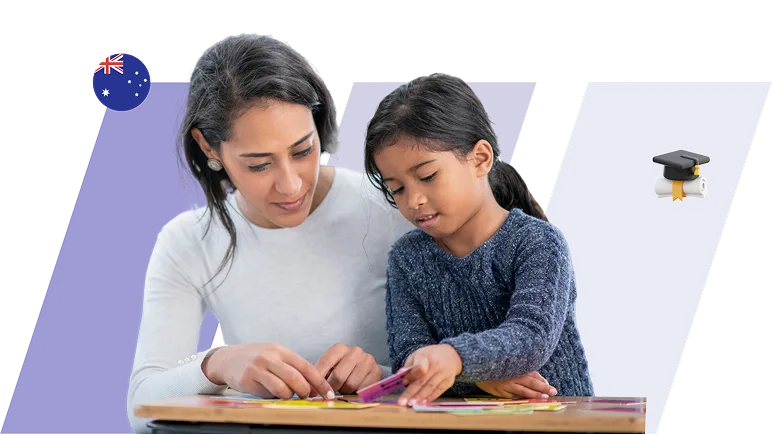
Health insurance is an essential requirement for a worry-free experience while studying abroad.
International Medical Coverage: Health insurance provides you with the peace of mind to receive medical care anywhere in the world, ensuring you won't face overwhelming expenses.
Visa and Enrollment Support:Having health insurance can make obtaining a student visa and enrollment easier. This reduces the chances of your applications being delayed or rejected.
Financial Protection: In the event of an unexpected incident, having health insurance ensures that your medical expenses are covered. It safeguards you from potential financial stress.
Legal Compliance: Many countries create specific health insurance for international students. Securing this insurance not only safeguards your well-being but also shields you from potential legal complications and the risk of deportation. Protect yourself and ensure a smooth study experience abroad.
Comprehensive Care: Health insurance covers expenses related to hospital stays, prescription medications, mental health support, and much more.
Register with Us to Take the Next Step
Country-wise rules
The USA has a unique system that students must navigate to meet certain criteria. In contrast, Australia requires international students to have Overseas Student Health Cover (OSHC). Similarly, in the UK, students are obligated to pay an Immigration Health Surcharge (IHS) to gain access to the National Health Service (NHS). Additionally, some universities have their own specific requirements, which often include particular coverage limits in their health insurance schemes.
Selecting a plan
Recognizing the diverse needs of students, universities create customized health insurance policies that provide essential coverage. Students can conveniently enroll in these plans during their registration process, ensuring peace of mind from day one. If a university does not offer its own insurance, students must seek private health insurance, which may not fully meet their specific needs. It's crucial for universities to invest in comprehensive health insurance options that prioritize student well-being and security.
Purchasing Health Insurance
Health insurance is essential for students, and selecting the right plan is vital for their well-being. By carefully considering their unique needs, students can find a plan that offers the best balance of cost and benefits. After choosing a suitable plan and making the necessary payment, students will receive a certificate as proof of their coverage, ensuring assurance during their academic journey.
Country-wise rules
The USA has a unique system that students must navigate to meet certain criteria. In contrast, Australia requires international students to have Overseas Student Health Cover (OSHC). Similarly, in the UK, students are obligated to pay an Immigration Health Surcharge (IHS) to gain access to the National Health Service (NHS). Additionally, some universities have their own specific requirements, which often include particular coverage limits in their health insurance schemes.
Country-wise rules
The USA has a unique system that students must navigate to meet certain criteria. In contrast, Australia requires international students to have Overseas Student Health Cover (OSHC). Similarly, in the UK, students are obligated to pay an Immigration Health Surcharge (IHS) to gain access to the National Health Service (NHS). Additionally, some universities have their own specific requirements, which often include particular coverage limits in their health insurance schemes.
Australia Parent Visa – Reunite Permanently with Your Parents
For many Australian residents and citizens, the toughest part of migrating isn’t the move itself—it’s the distance from loved ones. If you’re settled here and want to bring your parents closer, the Australia Parent Visa offers legal, long-term pathways for family reunification.
There are multiple visa options depending on your parents’ age, location, and your financial capacity. Some are low-cost with long queues. Others are faster, but come with higher government charges. This guide explains the key requirements and visa options so you can make informed decisions.
What Is the Parent Visa and Who Is Eligible?
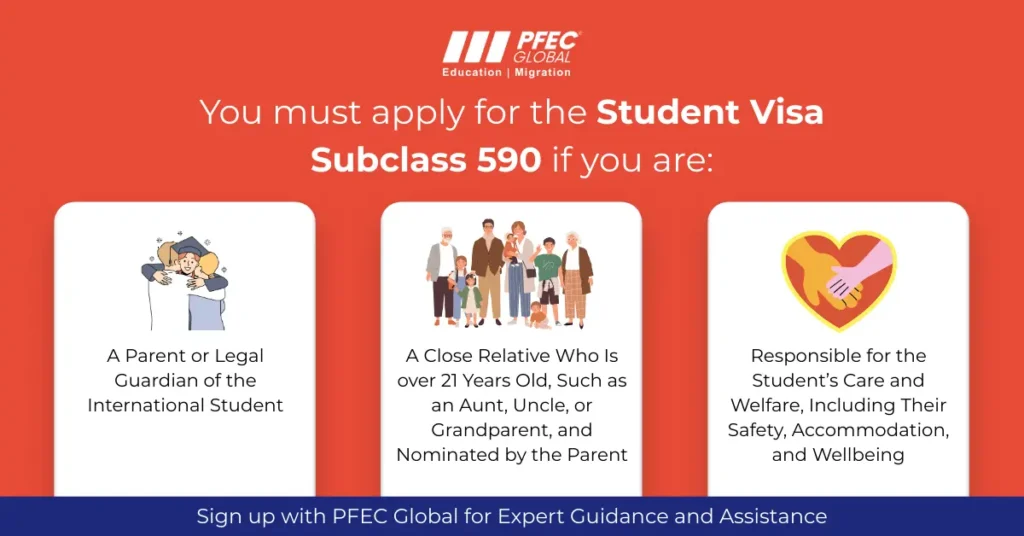
The Parent Visa allows parents of eligible children to live in Australia either temporarily or permanently. It supports family reunification, especially for parents in later life who wish to join their children in Australia.
To be eligible, the applicant must be the biological, adoptive, or step-parent of a person who is:
- An Australian citizen
- A permanent resident of Australia
- An eligible New Zealand citizen
There are different subclasses depending on whether the parent is onshore (in Australia) or offshore (outside Australia) at the time of application. Each has its own processing times, fees, and eligibility rules.
Most Parent Visas also require the applicant to:
- Meet the Balance of Family Test – at least half of their children must live permanently in Australia, or more children must live in Australia than in any other country.
- Have an eligible sponsor – typically the child inviting the parent.
Expert Insight: Contributory Parent Visas (Subclass 143, 864) are faster but significantly more expensive. Non-contributory visas (Subclass 103, 804) have lower fees but wait times of over 10 years.
Who Can Sponsor a Parent to Australia?
To apply for any Parent Visa for Australia, the parent must be sponsored by their child. The sponsor must meet all requirements set by the Department of Home Affairs.
Sponsor Eligibility Criteria
A sponsor must:
- Be at least 18 years old
- Be an Australian citizen, permanent resident, or eligible New Zealand citizen
- Have lived in Australia for at least 2 years
- Be the biological, adoptive, or step-child of the parent
- Agree to support the parent financially
- Provide an Assurance of Support, if required
The Assurance of Support (AoS) is a legal commitment to repay certain Centrelink payments your parent may claim. It may also involve a bond held by the government for up to 10 years.
If you have siblings in Australia, only one child needs to sponsor the parent. However, all children are considered in the Balance of Family Test.
Documents a Sponsor May Need
- Proof of citizenship or permanent residency
- Evidence of residence in Australia for 2+ years (e.g. utility bills, lease agreements)
- Recent tax returns or income statements
- Details of your living arrangements
- Evidence of relationship to the parent (e.g. birth certificate)
Expert Tip: Start gathering supporting documents early. Sponsors often underestimate how long it takes to organise official records.
Understanding the Balance of Family Test
The Balance of Family Test helps determine if a parent is eligible to apply for a Parent Visa. It assesses how many of the applicant’s children live lawfully and permanently in Australia.
To pass the test, one of the following must apply:
- At least half of the parent’s children live in Australia as:
- Australian citizens
- Australian permanent residents
- Eligible New Zealand citizens
- Australian citizens
- More children live in Australia than in any other single country
Children holding temporary visas (like student or visitor visas) are not counted for this test.
This test is mandatory for most parent visas, including:
- Contributory Parent Visa Subclass 143
- Aged Parent Visa Subclass 804
- Non-contributory Parent Visa Subclass 103
✅ Example:
A parent has four children:
- Two are Australian PRs living in Melbourne
- One lives in India
- One lives in Canada
This parent passes the Balance of Family Test.
Expert Tip: Before applying, list each child’s current country, visa status, and residency. This makes your eligibility clear and avoids delays.
Australia Parent Visa Types: A Complete Overview
Australia offers a range of parent visas depending on whether the applicant is onshore or offshore, their age, and how quickly they need to migrate.
Comparison of Key Parent Visa Subclasses
| Visa Subclass | Location | Type | Processing Time | Approx. Cost (AUD) |
|---|---|---|---|---|
| 804 | Onshore | Permanent | 30+ years (queued) | ~$6,500 |
| 884 | Onshore | Temporary | 3–5 years | ~$33,000 |
| 864 | Onshore | Permanent | 4–6 years | ~$48,000 |
| 173 | Offshore | Temporary | 4–6 years | ~$31,000 |
| 143 | Offshore | Permanent | 4–6 years | ~$47,000 |
| 103 | Offshore | Permanent | 30+ years (queued) | ~$6,000 |
- Contributory visas are processed faster but involve significantly higher costs
- Non-contributory visas are more affordable, but the queue can exceed 30 years
- Some applicants begin with a temporary visa (Subclass 173 or 884) before applying for a permanent option
Expert Tip: Plan for Assurance of Support (AoS), health checks, and other costs in addition to the visa application fee. These can affect overall readiness.
Aged Parent Visa (Subclass 804) – For Onshore Parents
The Aged Parent Visa Subclass 804 allows eligible older parents to stay in Australia permanently. This visa is only available onshore, and the applicant must meet the age requirement for the Age Pension (currently 67+ years).
Eligibility Criteria:
- Parent must be in Australia when applying and when the visa is granted
- Must be old enough to qualify for the Age Pension
- Must meet the Balance of Family Test
- Requires sponsorship by an eligible child
What It Offers:
- Permanent residency in Australia
- Access to Medicare and public services
- Ability to stay on a Bridging Visa while waiting for the outcome
Limitations:
- Extremely long queue (30+ years average)
- Annual cap on places available
- No priority processing options
Who is it for?
This visa suits parents already in Australia on a visitor or bridging visa who are prepared to wait and want to remain in the country during the process.
Expert Insight: While the Subclass 804 is low-cost, applicants should have realistic expectations about the waiting period. For faster options, explore contributory visas like Subclass 864.
Contributory Aged Parent Visas (Subclass 884 & 864) – Faster Onshore Pathway
If your parent is already in Australia and meets the age requirement for the Age Pension, the Subclass 884 and 864 visa pathway offers a faster route to permanent residency compared to Subclass 804.
Step 1: Apply for Subclass 884 (Temporary Visa)
- 2-year temporary stay
- Must apply onshore while holding a valid visa
- Access to Medicare and work rights
- Must pass the Balance of Family Test
- Requires sponsorship and Assurance of Support
Step 2: Transition to Subclass 864 (Permanent Visa)
- Apply before the Subclass 884 visa expires
- Grants permanent residency in Australia
- Applicant can stay on a bridging visa while waiting for approval
Key Points:
| Feature | Subclass 884/864 |
|---|---|
| Total Cost | ~$48,000 AUD |
| Processing Time | ~4–6 years |
| Sponsorship | Required |
| Location | Onshore only |
| Assurance of Support | Yes (10-year commitment) |
Contributory Parent Visas (Subclass 173 & 143) – Offshore Option for Faster Migration
- 2-year visa for offshore applicants
- Access to Medicare and work rights
- Requires the Balance of Family Test and sponsorship
- Allows entry and temporary stay in Australia
- Must apply within 2 years of holding Subclass 173
- Grants permanent residency
- Can remain in Australia while the 143 visa is being processed
| Feature | Subclass 173/143 |
|---|---|
| Total Cost | ~$47,000–$50,000 AUD |
| Processing Time | ~4–6 years combined |
| Sponsorship | Required |
| Location | Offshore start, onshore finish allowed |
| Assurance of Support | Yes |
Parent Visa (Subclass 103) – Low Cost, Long Wait
The Parent Visa Subclass 103 is a non-contributory permanent residency visa for parents applying from outside Australia. It is the most affordable option—but has one of the longest queues.
Key Features:
- Offers permanent residency once granted
- Requires a child who is an Australian citizen, PR, or eligible NZ citizen
- Must pass the Balance of Family Test
- Includes Assurance of Support
- Must be offshore during application and grant
Cost & Timeline:
| Detail | Subclass 103 |
|---|---|
| Visa Cost | ~$6,000 AUD |
| Processing Time | 30+ years (queued) |
| Annual Cap | Yes – limited places per year |
| Bridging Visa | Not available from offshore |
Benefits and Limitations of Parent Visa Holders in Australia
Permanent parent visa holders in Australia enjoy several long-term entitlements, but there are also important limitations to be aware of—especially for temporary visa holders.
✅ What Parent Visa Holders Can Access (Permanent Visas)
If granted a permanent parent visa (Subclass 103, 143, or 864), holders can:
- Live in Australia permanently
- Work and study without restrictions
- Access Medicare (Australia’s public healthcare system)
- Apply for Australian citizenship, if eligible
❌ What Is Not Automatically Included
Parent visa holders do not get access to all services immediately:
- Age Pension has a 10-year residency waiting period
- Temporary visa holders (Subclass 173, 884) cannot access Centrelink or social security
- No automatic welfare or housing assistance
- Private health insurance may be required for temporary visas
Expert Insight: Financial planning is essential. Medicare only covers basic healthcare—so budget for out-of-pocket medical needs and living expenses during the early years.
Visa Costs and Financial Requirements (AUD)
Australia’s parent visa program includes high financial thresholds—especially for contributory options. Here’s a comparison to help you plan:
| Visa Subclass | Type | Estimated Cost (AUD) | Notes |
|---|---|---|---|
| 103 | Permanent (Offshore) | ~$6,000 | Long wait; includes AoS |
| 804 | Permanent (Onshore) | ~$6,500 | 30+ years queue |
| 884 | Temporary (Onshore) | ~$33,000 | First step toward 864 |
| 864 | Permanent (Onshore) | ~$48,000 (total) | Faster processing |
| 173 | Temporary (Offshore) | ~$31,000 | Entry point to 143 |
| 143 | Permanent (Offshore) | ~$47,000 (total) | Direct PR after 173 |
What is the Assurance of Support (AoS)?
- A financial bond provided by the sponsor
- Usually $10,000+ per applicant, held for 10 years
- Guarantees the parent will not rely on government welfare
Expert Tip: For contributory visas, AoS is mandatory. Some sponsors pool funds from multiple family members to meet this requirement.
Choosing the Right Parent Visa for Your Family
Each parent visa subclass has pros and cons. Your choice depends on timing, location, age, and finances.
Key Considerations:
- Is your parent already in Australia?
→ Look at Subclass 804, 884, or 864 - Is your parent over Age Pension age (currently 67+)?
→ Needed for Aged Parent Visas - Do you want faster processing?
→ Choose Subclass 143 or 864 (contributory) - Need a low-cost visa and can wait?
→ Consider Subclass 103 or 804 - Can you provide Assurance of Support?
→ Required for contributory options
Expert Insight: Many families apply for a contributory temporary visa (884 or 173) first, then transition to permanent status (864 or 143). This allows parents to enter Australia sooner.
Why Choose PFEC Global for Your Parent Visa Application?
Applying for an Australian parent visa is complex. Mistakes or missing documents lead to years of delays—or refusals. PFEC Global simplifies the journey.
Why Families Trust PFEC:
- ✅ Step-by-step guidance from eligibility to grant
- ✅ Support for both offshore and onshore applications
- ✅ Accurate advice on sponsorship, AoS, and visa strategy
- ✅ Expertise in navigating long queues and contributory streams
- ✅ Help with documents, bridging visas, Medicare access, and more
Expert Insight: The right strategy depends on your parent’s location, your financial situation, and how soon you want them in Australia. Our experts help you avoid costly delays.
FAQs – Australia Parent Visa Explained
What is the Balance of Family Test?
To pass, either:
- At least half of your children must live legally and permanently in Australia, or
- More children live in Australia than in any other single country
Children on temporary visas (e.g., student or bridging) are not counted.
Can my parents apply while visiting Australia?
Yes, if they meet requirements for:
- Aged Parent Visa (Subclass 804)
- Contributory Aged Parent Visa (Subclass 884)
They must be in Australia on a valid visa and meet age, health, and sponsorship conditions. A bridging visa may let them stay during processing.
What’s the difference between contributory and non-contributory parent visas?
| Feature | Contributory | Non-Contributory |
|---|---|---|
| Cost | High (~$47,000+) | Low (~$6,000) |
| Wait Time | 4–6 years | 30+ years |
| Examples | 143, 864 | 103, 804 |
How long does it take to get a Parent Visa?
- Subclass 143 / 864: 4–6 years
- Subclass 173 / 884: 3–5 years
- Subclass 103 / 804: 30+ years (queued)
Do Parent Visa holders get Medicare or Centrelink?
- Permanent visa holders can enrol in Medicare
- Temporary visa holders (173, 884): No social security, limited health access
- No Centrelink access for up to 10 years after PR is granted
Ready to Apply for Your Australian Partner Visa?
You deserve to live with your partner—without long-distance stress or uncertainty. Let PFEC help you make that future a reality.
📞 Book a free consultation with a PFEC Partner Visa expert
📄 Download our Partner Visa Checklist to prepare your documents without confusion
🤝 Get trusted support from people who understand both Australian law and your personal journey
Simplify your Education & Migration Needs with PFEC Global's Expert Guidance
Book Free Consultation →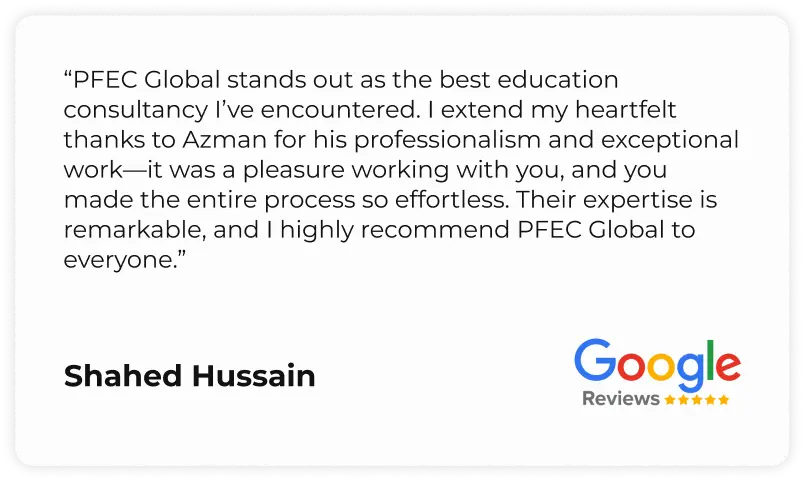
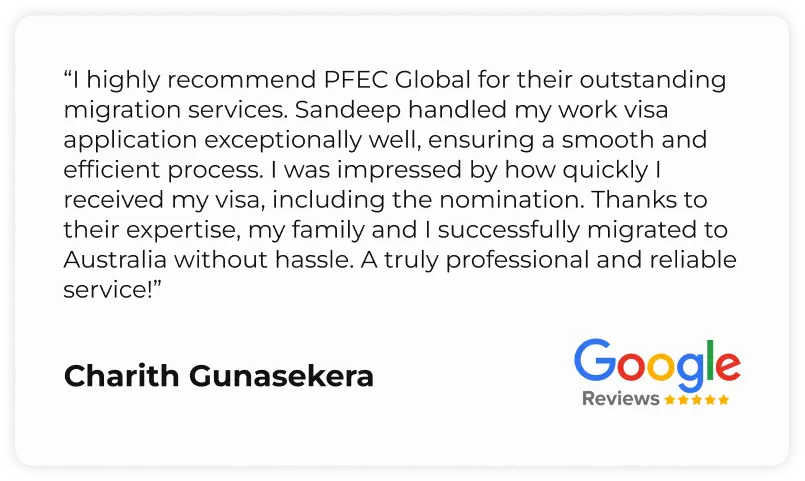
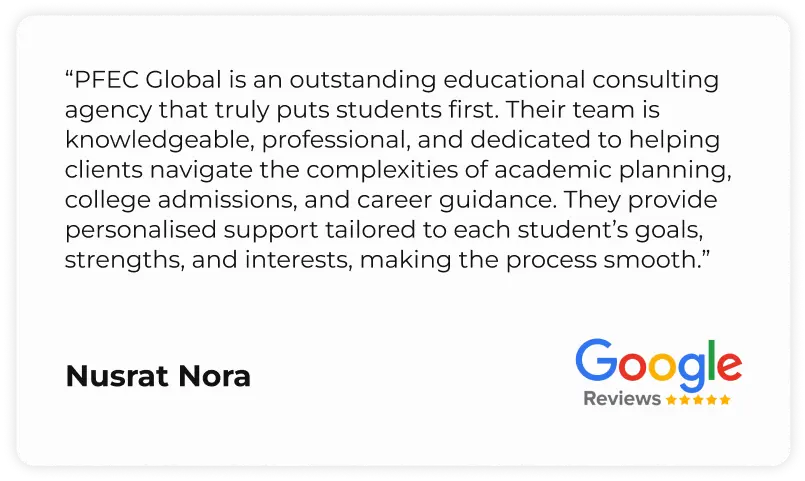
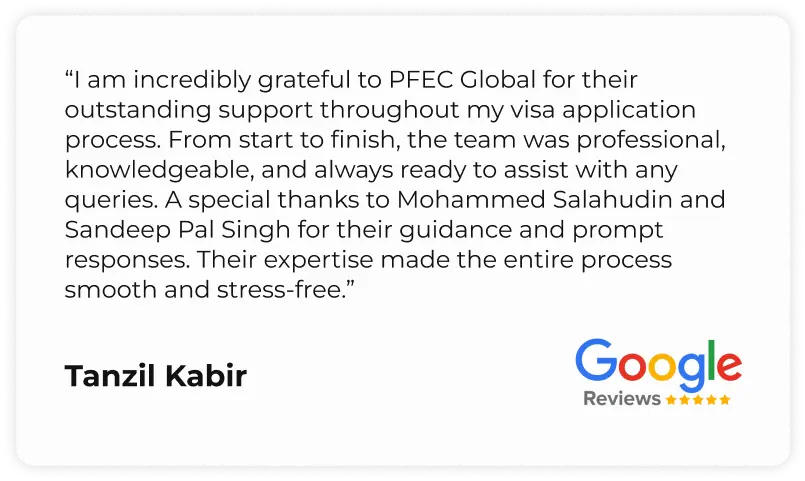
What are my options and possibilities for submitting an Australian PR application?
Depending on your situation, you have many options when applying for an Australian Permanent Residency (PR). The Skilled Work Regional (Provisional) Visa (Subclass 491) is for regional employment; the Skilled Nominated Visa (Subclass 190) is for skilled workers who need state or territory nomination. There are several routes for family sponsorship and employer-sponsored visas, each with particular perks and requirements
If I don't have enough points to submit an application for a PR. What are my options?
If your points total is not enough for a PR application, think about being nominated by a state or territory, which may provide more points. Getting additional job experience, taking language exams like the PTE or IELTS, or going to further school in Australia to improve your credentials are all good ways to improve your English.
Does applying for a new course and student visa when I know my TR (Temporary Resident) is about to expire present any risks?
Applying for a new PR pathway courses in Australia and a student visa while your Temporary Resident visa is about to expire might be dangerous. To prevent possible visa denial, make sure your application is complete and satisfies all Department of Home Affairs standards. Learn the terms of any bridging visa that could be applicable throughout the application process, and if you’re not sure whether your application is complete or if you qualify, get expert help.